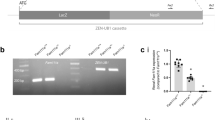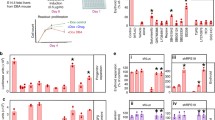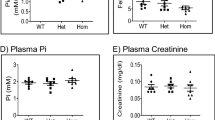Abstract
Thiamine-responsive megaloblastic anaemia with diabetes and deafness1 (TRMA; MIM 249270) is an autosomal recessive disease thought to be due to a defect in thiamine (vitamin B1) transport2,3. Pharmacological doses of thiamine correct the anaemia, and in some cases improve the diabetes, although progressive sensorineural deafness is irreversible4. Previous studies localized the TRMA gene to a 4-cM region on chromosome 1q23.3 (ref. 5), and fine-mapping has recently narrowed that region further6,7. We have previously demonstrated that fibroblasts from people with TRMA lack high-affinity thiamine transport8. Expression of a gene encoding a known yeast thiamine transporter, THI10 (refs 8,9,10), in TRMA mutant cells prevents apoptotic cell death in thiamine-depleted medium. On the basis of these studies, we hypothesized that a defective thiamine transporter causes TRMA. We undertook a candidate gene approach to identify putative thiamine transporters in the 1q23.3 critical region. Here we present evidence that the gene SLC19A2 (for solute carrier family 19 (thiamine transporter), member 2) encodes the first known mammalian thiamine transporter, which we designate thiamine transporter-1 (THTR-1).
This is a preview of subscription content, access via your institution
Access options
Subscribe to this journal
Receive 12 print issues and online access
$209.00 per year
only $17.42 per issue
Buy this article
- Purchase on Springer Link
- Instant access to full article PDF
Prices may be subject to local taxes which are calculated during checkout





Similar content being viewed by others
References
Rogers, L.E., Porter, F.S. & Sidbury, J.B.J. Thiamine-responsive megaloblastic anemia. J. Pediatr. 74, 494–504 (1969).
Poggi, V. et al. Thiamin-responsive megaloblastic anemia: a disorder of thiamin transport? J. Inherit. Metab. Dis. 7 (suppl. 2), 153–154 (1984).
Rindi, G. et al. Thiamine transport by erythrocytes and ghosts in thiamine-responsive megaloblastic anemia. J. Inherit. Metab. Dis. 15, 231–242 (1992).
Neufeld, E.J. et al. Localization of the gene for thiamine-responsive anemia syndrome on the long arm of chromosome 1 by homozygosity mapping. Am. J. Hum. Genet. 61, 1335–1341 (1997).
Raz, T. et al. Refined mapping of the gene for thiamine-responsive megaloblastic anemia syndrome and evidence for genetic homogeneity. Hum. Genet. 103, 455–461 ( 1998).
Banikazemi, M. et al. Localization of the thiamine-responsive megaloblastic anemia syndrome locus to a 1.4-cM region of 1q23. Mol. Genet. Metab. 66, 193–198 (1999).
Labay, V. et al. Mutations in SLC19A2 cause thiamine-responsive megaloblastic anemia associated with diabetes mellitus and deafness. Nature Genet. 22, 300–304 ( 1999).
Stagg, A.R. et al. Defective high-affinity thiamine transporter leads to cell death in thiamine-responsive megaloblastic anemia syndrome fibroblasts. J. Clin. Invest. 103, 723–729 (1999).
Enjo, F., Nosaka, K., Ogata, M., Iwashima, A. & Nishimura, H. Isolation and characterization of a thiamine transport gene, THI10, from Saccharomyces cerevisiae. J. Biol. Chem. 272, 19165–19170 ( 1997).
Singleton, C.K. Identification and characterization of the thiamine transporter gene of Saccharomyces cerevisiae. Gene 199, 111–121 (1997).
Altschul, S.F. et al. Gapped BLAST and PSI-BLAST: a new generation of protein database search programs. Nucleic Acids Res. 25, 3389–3402 (1997).
Prasad, P.D., Ramamoorthy, S., Leibach, F.H. & Ganapathy, V. Molecular cloning of the human placental folate transporter. Biochem. Biophys. Res. Commun. 206, 681–687 (1995).
Wong, S.C., Proefke, S.A., Bhushan, A. & Matherly, L.H. Isolation of human cDNAs that restore methotrexate sensitivity and reduced folate carrier activity in methotrexate transport-defective Chinese hamster ovary cells. J. Biol. Chem. 270, 17468– 17475 (1995).
Rost, B., Casadio, R., Fariselli, P. & Sander, C. Transmembrane helices predicted at 95% accuracy. Protein Sci. 4, 521–533 (1995).
Sambrook, J., Fritsch, E.F. & Maniatis, T. Molecular Cloning. A Laboratory Manual (Cold Spring Harbor Laboratory Press, Cold Spring Harbor, 1989).
Fleming, M.D. et al. Nramp2 is mutated in the anemic Belgrade (b) rat: evidence of a role for Nramp2 in endosomal iron transport. Proc. Natl Acad. Sci. USA 95, 1148–1153 ( 1998).
Bairoch, A., Bucher, P. & Hofman, K. The PROSITE database, its status in 1997. Nucleic Acids Res. 25, 217–221 (1997).
Bonthron, D.T. et al. Structure of pre-pro-von Willebrand factor and its expression in heterologous cells. Nature 324, 270– 273 (1986).
Acknowledgements
We thank M. Fleming for helpful advice, A. Stagg for technical assistance, D. Fenske, and patients and their families. This work was supported by the March of Dimes (E.J.N.) and NIH training grant T32 HL07574 (J.C.F.).
Author information
Authors and Affiliations
Corresponding author
Rights and permissions
About this article
Cite this article
Fleming, J., Tartaglini, E., Steinkamp, M. et al. The gene mutated in thiamine-responsive anaemia with diabetes and deafness (TRMA) encodes a functional thiamine transporter. Nat Genet 22, 305–308 (1999). https://doi.org/10.1038/10379
Received:
Accepted:
Issue Date:
DOI: https://doi.org/10.1038/10379
This article is cited by
-
Pharmacogenomics in diabetes: outcomes of thiamine therapy in TRMA syndrome
Diabetologia (2018)
-
Not quite type 1 or type 2, what now? Review of monogenic, mitochondrial, and syndromic diabetes
Reviews in Endocrine and Metabolic Disorders (2018)
-
A novel homozygous SLC19A2 mutation in a Portuguese patient with diabetes mellitus and thiamine-responsive megaloblastic anaemia
International Journal of Pediatric Endocrinology (2015)
-
Involvement of Organic Cation Transporters in the Clearance and Milk Secretion of Thiamine in Mice
Pharmaceutical Research (2015)
-
Association of TM4SF4 with the Human Thiamine Transporter-2 in Intestinal Epithelial Cells
Digestive Diseases and Sciences (2014)



